Shift KIA PICANTO 2006 Owners Manual
[x] Cancel search | Manufacturer: KIA, Model Year: 2006, Model line: PICANTO, Model: KIA PICANTO 2006Pages: 281, PDF Size: 9.89 MB
Page 9 of 281
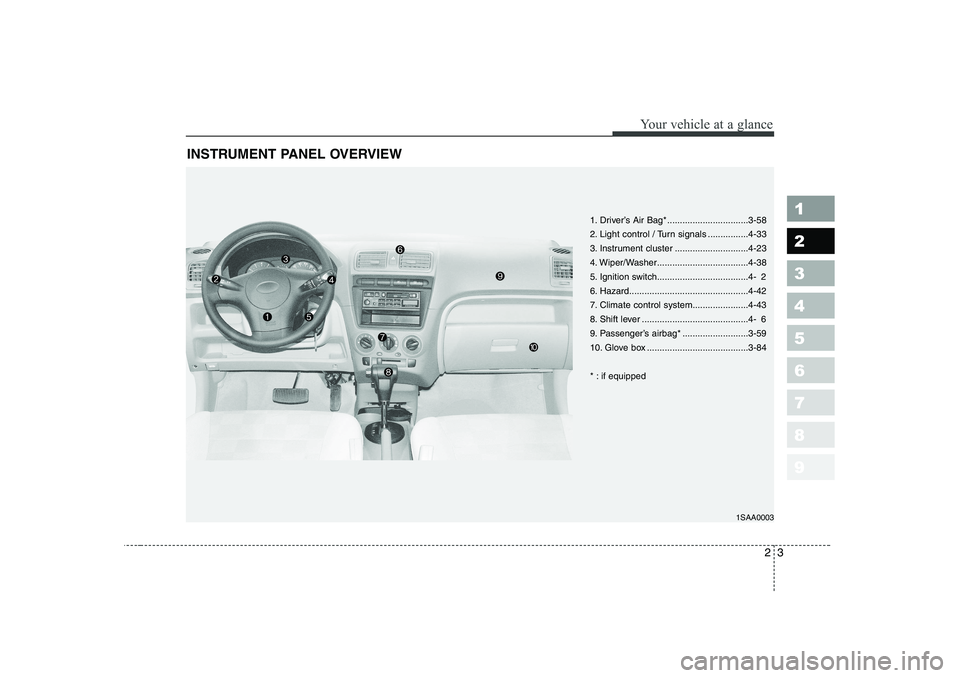
23
1 23456789
Your vehicle at a glance
INSTRUMENT PANEL OVERVIEW
1. Driver’s Air Bag* ................................3-58
2. Light control / Turn signals ................4-33
3. Instrument cluster .............................4-23
4. Wiper/Washer....................................4-38
5. Ignition switch....................................4- 2
6. Hazard...............................................4-42
7. Climate control system......................4-43
8. Shift lever ..........................................4- 6
9. Passenger’s airbag* ..........................3-59
10. Glove box ........................................3-84
* : if equipped1SAA0003
Page 39 of 281
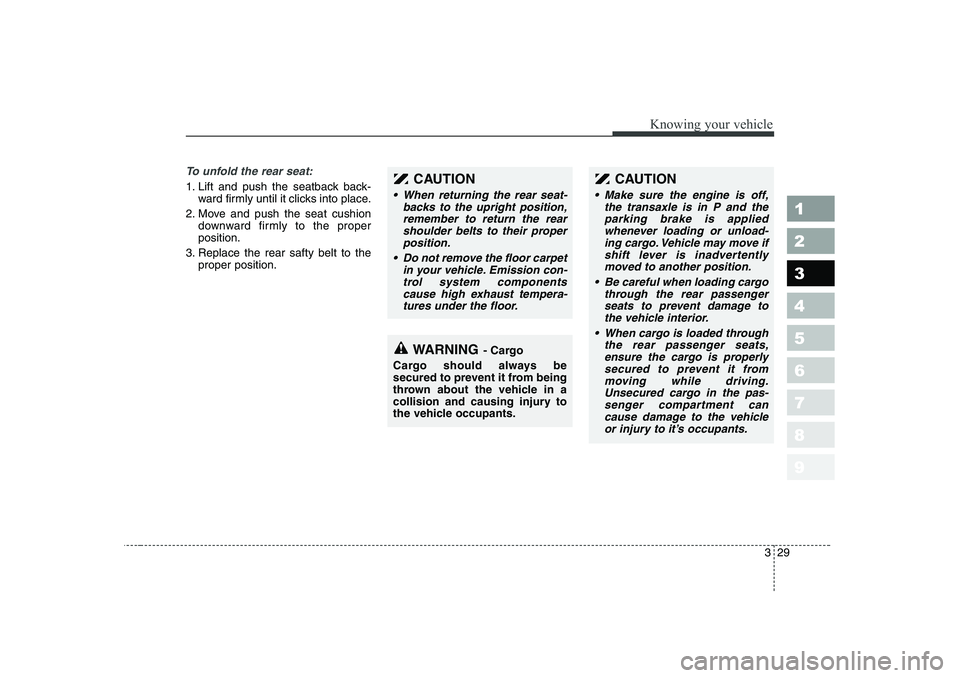
329
1 23456789
Knowing your vehicle
To unfold the rear seat:
1. Lift and push the seatback back-ward firmly until it clicks into place.
2. Move and push the seat cushion downward firmly to the proper position.
3. Replace the rear safty belt to the proper position.CAUTION
When returning the rear seat-
backs to the upright position,remember to return the rearshoulder belts to their properposition.
Do not remove the floor carpet in your vehicle. Emission con-trol system componentscause high exhaust tempera-tures under the floor.
WARNING - Cargo
Cargo should always be
secured to prevent it from being
thrown about the vehicle in a
collision and causing injury to
the vehicle occupants.
CAUTION
Make sure the engine is off, the transaxle is in P and theparking brake is applied whenever loading or unload-ing cargo. Vehicle may move ifshift lever is inadvertently moved to another position.
Be careful when loading cargo through the rear passengerseats to prevent damage tothe vehicle interior.
When cargo is loaded through the rear passenger seats,ensure the cargo is properlysecured to prevent it frommoving while driving. Unsecured cargo in the pas-senger compartment cancause damage to the vehicle or injury to it’s occupants.
Page 100 of 281
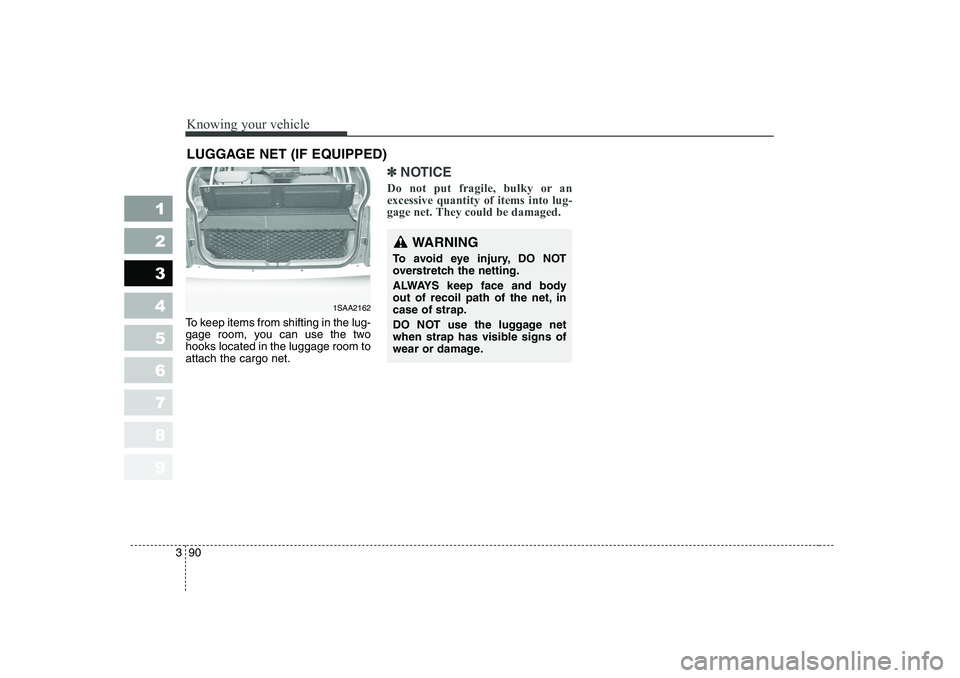
Knowing your vehicle
90
3
1 23456789
To keep items from shifting in the lug-
gage room, you can use the twohooks located in the luggage room toattach the cargo net.
✽✽
NOTICE
Do not put fragile, bulky or an excessive quantity of items into lug-
gage net. They could be damaged.
LUGGAGE NET (IF EQUIPPED)
1SAA2162
WARNING
To avoid eye injury, DO NOT
overstretch the netting.
ALWAYS keep face and body
out of recoil path of the net, incase of strap.
DO NOT use the luggage net
when strap has visible signs of
wear or damage.
Page 104 of 281
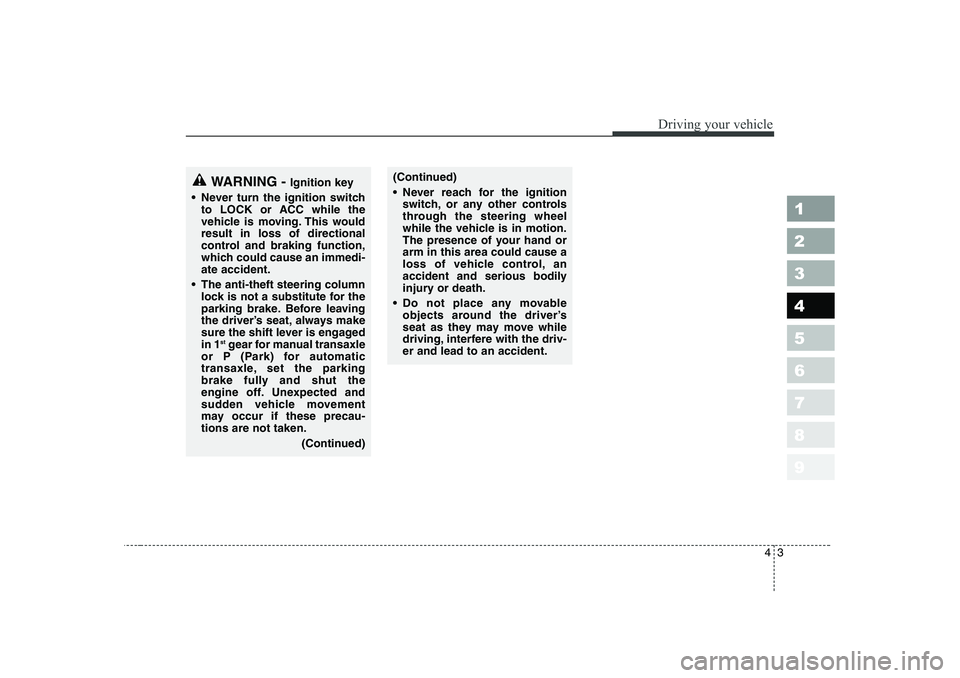
43
1 23456789
Driving your vehicle
(Continued)
• Never reach for the ignitionswitch, or any other controls
through the steering wheel
while the vehicle is in motion.
The presence of your hand orarm in this area could cause a
loss of vehicle control, an
accident and serious bodily
injury or death.
Do not place any movable objects around the driver’s
seat as they may move while
driving, interfere with the driv-er and lead to an accident.WARNING - Ignition key
Never turn the ignition switch to LOCK or ACC while the
vehicle is moving. This wouldresult in loss of directional
control and braking function,
which could cause an immedi-ate accident.
The anti-theft steering column lock is not a substitute for the
parking brake. Before leaving
the driver’s seat, always make
sure the shift lever is engagedin 1 st
gear for manual transaxle
or P (Park) for automatic
transaxle, set the parking
brake fully and shut the
engine off. Unexpected and
sudden vehicle movement
may occur if these precau-tions are not taken.
(Continued)
Page 105 of 281
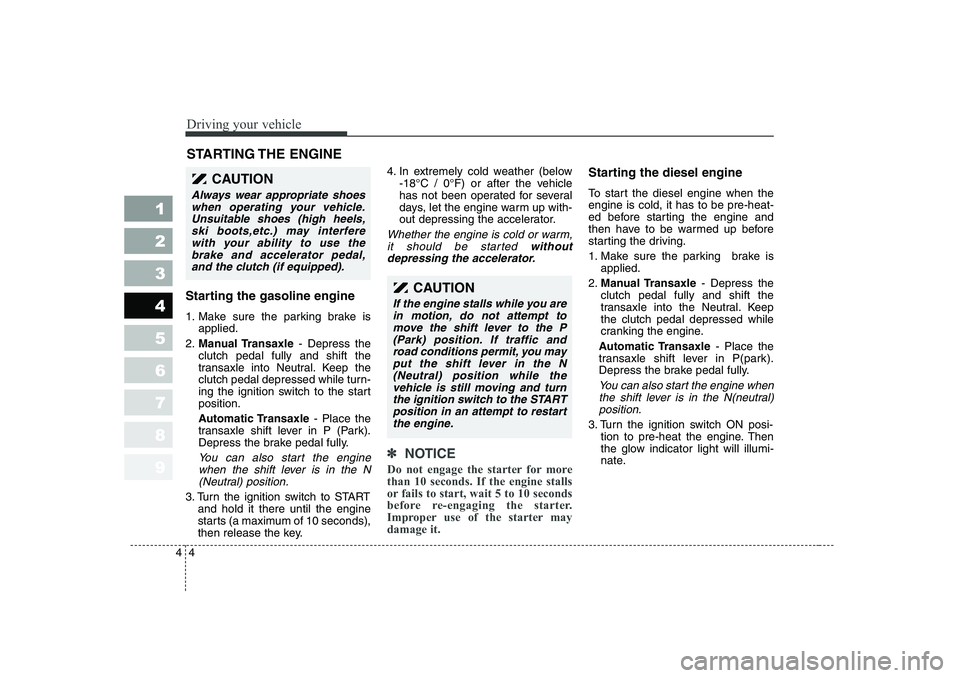
Driving your vehicle
4
4
1 23456789
Starting the gasoline engine
1. Make sure the parking brake is
applied.
2. Manual Transaxle - Depress the
clutch pedal fully and shift the
transaxle into Neutral. Keep the
clutch pedal depressed while turn-
ing the ignition switch to the startposition.
Automatic Transaxle - Place the
transaxle shift lever in P (Park).
Depress the brake pedal fully.
You can also start the engine
when the shift lever is in the N(Neutral) position.
3. Turn the ignition switch to START and hold it there until the engine
starts (a maximum of 10 seconds),
then release the key. 4. In extremely cold weather (below
-18°C / 0°F) or after the vehicle
has not been operated for several
days, let the engine warm up with-
out depressing the accelerator.
Whether the engine is cold or warm,
it should be started without
depressing the accelerator.
✽✽
NOTICE
Do not engage the starter for more than 10 seconds. If the engine stalls
or fails to start, wait 5 to 10 seconds
before re-engaging the starter.
Improper use of the starter maydamage it.
Starting the diesel engine
To start the diesel engine when the engine is cold, it has to be pre-heat-
ed before starting the engine and
then have to be warmed up before
starting the driving.
1. Make sure the parking brake is applied.
2. Manual Transaxle - Depress the
clutch pedal fully and shift the
transaxle into the Neutral. Keepthe clutch pedal depressed while
cranking the engine.
Automatic Transaxle - Place the
transaxle shift lever in P(park).
Depress the brake pedal fully.
You can also start the engine when
the shift lever is in the N(neutral)position.
3. Turn the ignition switch ON posi- tion to pre-heat the engine. Then
the glow indicator light will illumi-
nate.
STARTING THE ENGINE
CAUTION
If the engine stalls while you are
in motion, do not attempt tomove the shift lever to the P(Park) position. If traffic and road conditions permit, you mayput the shift lever in the N(Neutral) position while the vehicle is still moving and turnthe ignition switch to the STARTposition in an attempt to restart the engine.
CAUTION
Always wear appropriate shoeswhen operating your vehicle.Unsuitable shoes (high heels,ski boots,etc.) may interfere with your ability to use thebrake and accelerator pedal,and the clutch (if equipped).
Page 107 of 281
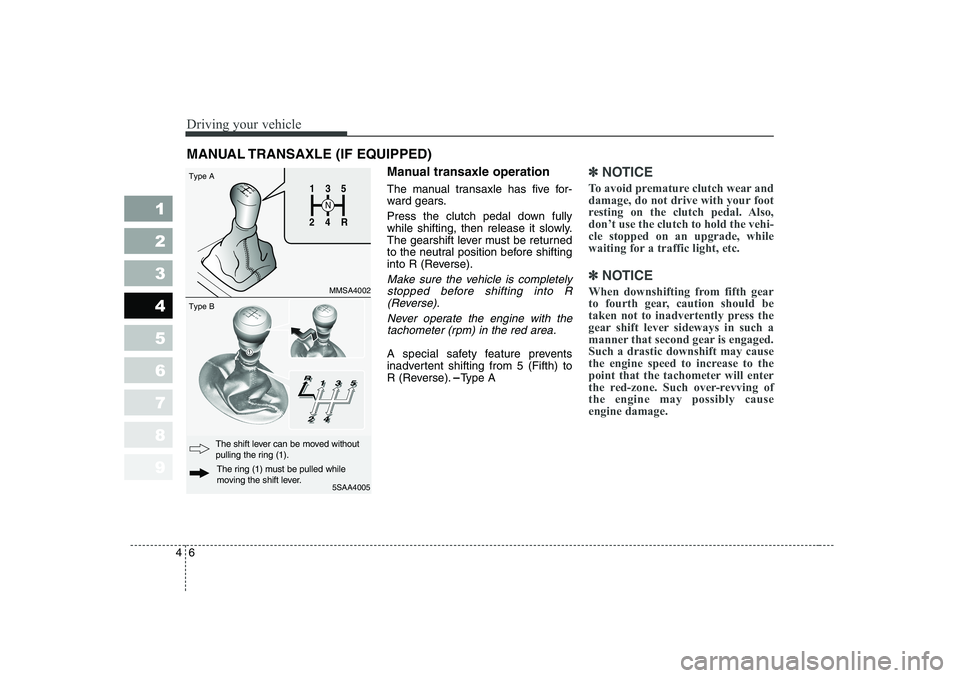
Driving your vehicle
6
4
1 23456789
Manual transaxle operation
The manual transaxle has five for-
ward gears.
Press the clutch pedal down fully
while shifting, then release it slowly.
The gearshift lever must be returned
to the neutral position before shifting
into R (Reverse).
Make sure the vehicle is completely
stopped before shifting into R(Reverse).
Never operate the engine with thetachometer (rpm) in the red area.
A special safety feature prevents
inadvertent shifting from 5 (Fifth) to
R (Reverse). Type A
✽✽ NOTICE
To avoid premature clutch wear and
damage, do not drive with your foot
resting on the clutch pedal. Also,don’t use the clutch to hold the vehi-cle stopped on an upgrade, while
waiting for a traffic light, etc.
✽
✽ NOTICE
When downshifting from fifth gear
to fourth gear, caution should be
taken not to inadvertently press the
gear shift lever sideways in such a
manner that second gear is engaged.Such a drastic downshift may cause
the engine speed to increase to the
point that the tachometer will enter
the red-zone. Such over-revving ofthe engine may possibly causeengine damage.
MANUAL TRANSAXLE (IF EQUIPPED)
1
2 4
R
3
S
N
135
R
4
2
5SAA4005
Type A Type B
MMSA4002
The ring (1) must be pulled while
moving the shift lever.
The shift lever can be moved without
pulling the ring (1).
Page 108 of 281
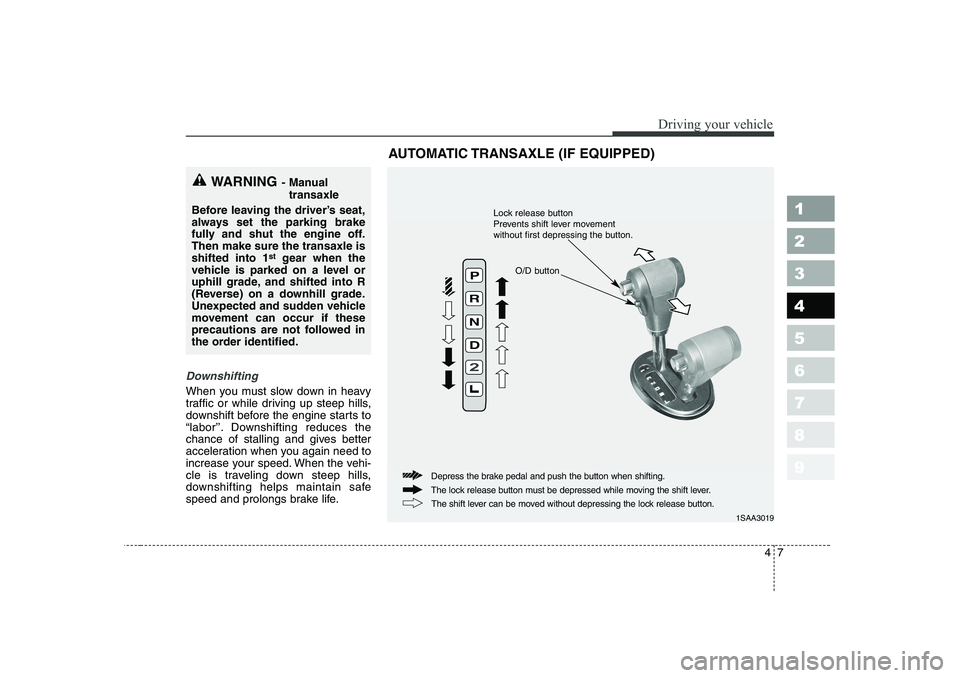
47
1 23456789
Driving your vehicle
Downshifting
When you must slow down in heavy
traffic or while driving up steep hills,
downshift before the engine starts to“labor ’’. Downshifting reduces the
chance of stalling and gives better
acceleration when you again need to
increase your speed. When the vehi-
cle is traveling down steep hills,
downshifting helps maintain safe
speed and prolongs brake life.
1SAA3019
The lock release button must be depressed while moving the shift lever.
The shift lever can be moved without depressing the lock release button.
Depress the brake pedal and push the button when shifting. Lock release button
Prevents shift lever movement
without first depressing the button.
O/D button
WARNING - Manual
transaxle
Before leaving the driver ’s seat,
always set the parking brake
fully and shut the engine off.Then make sure the transaxle isshifted into 1 st
gear when the
vehicle is parked on a level or
uphill grade, and shifted into R
(Reverse) on a downhill grade.
Unexpected and sudden vehicle
movement can occur if these
precautions are not followed in
the order identified.
AUTOMATIC TRANSAXLE (IF EQUIPPED)
Page 109 of 281
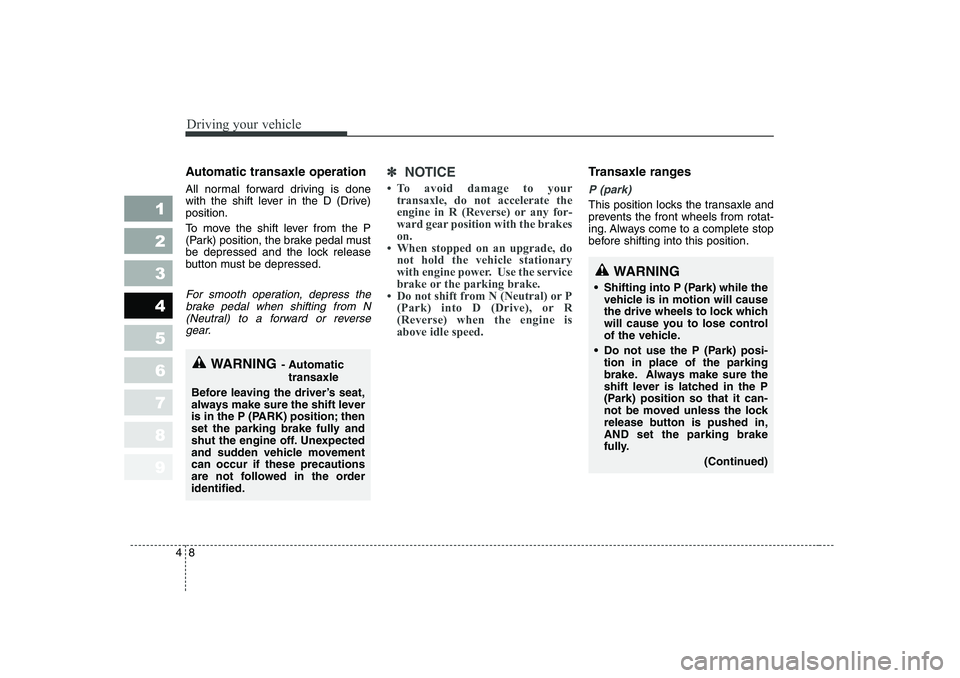
Driving your vehicle
8
4
1 23456789
Automatic transaxle operation
All normal forward driving is done
with the shift lever in the D (Drive)position.
To move the shift lever from the P
(Park) position, the brake pedal must
be depressed and the lock release
button must be depressed.
For smooth operation, depress the
brake pedal when shifting from N(Neutral) to a forward or reverse gear.
✽✽
NOTICE
Page 110 of 281
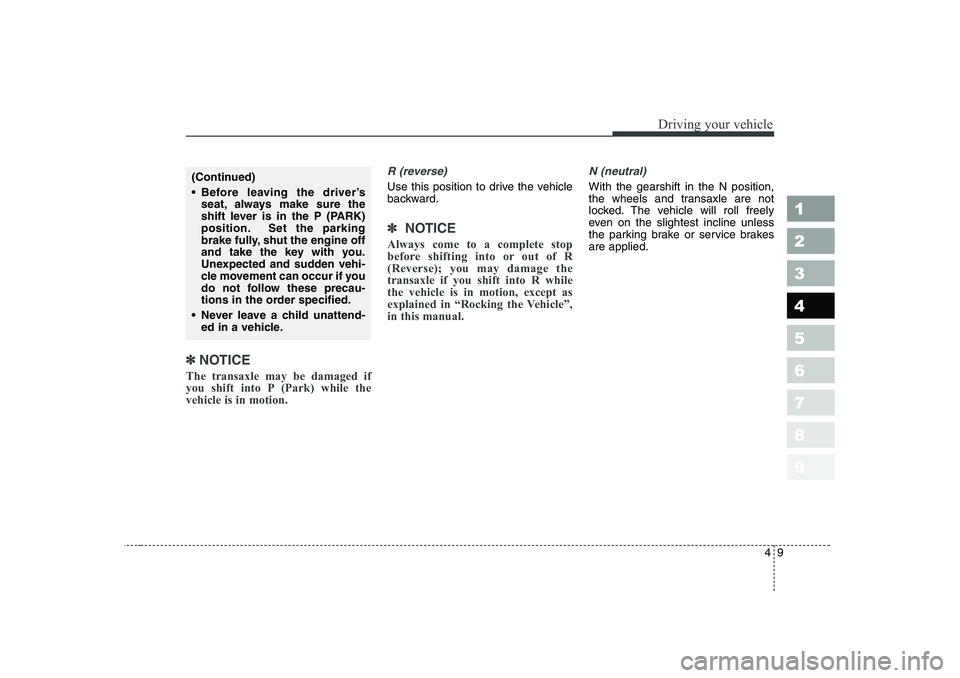
49
1 23456789
Driving your vehicle
✽✽
NOTICE
The transaxle may be damaged if
you shift into P (Park) while thevehicle is in motion.
R (reverse)
Use this position to drive the vehicle
backward.
✽✽
NOTICE
Always come to a complete stop
before shifting into or out of R(Reverse); you may damage thetransaxle if you shift into R whilethe vehicle is in motion, except as
explained in “Rocking the Vehicle”,in this manual.
N (neutral)
With the gearshift in the N position,
the wheels and transaxle are not
locked. The vehicle will roll freely
even on the slightest incline unless
the parking brake or service brakesare applied.(Continued) Before leaving the driver ’s
seat, always make sure the
shift lever is in the P (PARK)
position. Set the parking
brake fully, shut the engine off
and take the key with you.
Unexpected and sudden vehi-
cle movement can occur if you
do not follow these precau-
tions in the order specified.
Never leave a child unattend-
ed in a vehicle.
Page 111 of 281
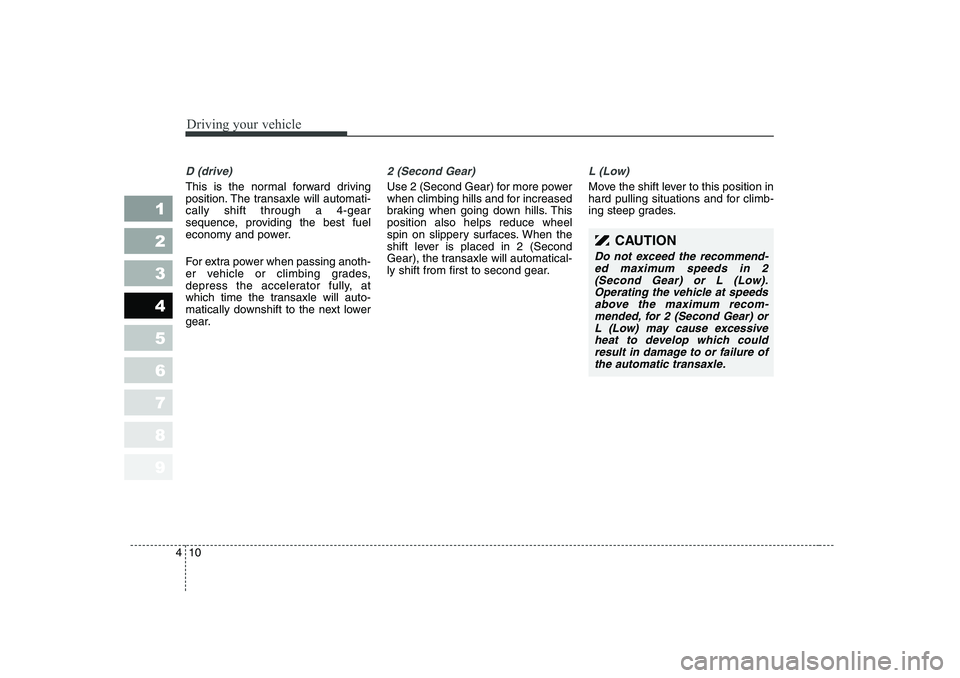
Driving your vehicle
10
4
1 23456789
CAUTION
Do not exceed the recommend-
ed maximum speeds in 2(Second Gear) or L (Low).Operating the vehicle at speeds above the maximum recom-mended, for 2 (Second Gear) orL (Low) may cause excessiveheat to develop which could result in damage to or failure ofthe automatic transaxle.
D (drive)
This is the normal forward driving
position. The transaxle will automati-cally shift through a 4-gear
sequence, providing the best fuel
economy and power.
For extra power when passing anoth-
er vehicle or climbing grades,
depress the accelerator fully, at
which time the transaxle will auto-
matically downshift to the next lower
gear.
2 (Second Gear)
Use 2 (Second Gear) for more power
when climbing hills and for increased
braking when going down hills. Thisposition also helps reduce wheel
spin on slippery surfaces. When the
shift lever is placed in 2 (Second
Gear), the transaxle will automatical-
ly shift from first to second gear.
L (Low)
Move the shift lever to this position in
hard pulling situations and for climb-
ing steep grades.